Hidden beneath the bustling streets of Alexandria lies one of Egypt’s most fascinating yet underrated archaeological wonders—the Catacombs of Kom El Shoqafa. This subterranean burial site is a remarkable testament to the cultural and artistic fusion of Egyptian, Greek, and Roman civilizations. Built in the 2nd century AD, the catacombs provide an extraordinary glimpse into ancient funerary traditions, architectural ingenuity, and the multicultural heritage of Alexandria. Accidentally rediscovered in 1900, the site has since intrigued historians, archaeologists, and visitors alike.
The Historical Significance of the Catacombs
The Catacombs of Kom El Shoqafa date back to the 2nd century AD, during the height of Roman rule in Egypt. Initially intended as a private tomb for a wealthy family, the site expanded over time to accommodate more individuals, eventually serving as a vast necropolis. Unlike traditional Egyptian tombs built in the desert, these catacombs were carved directly into the bedrock beneath Alexandria.
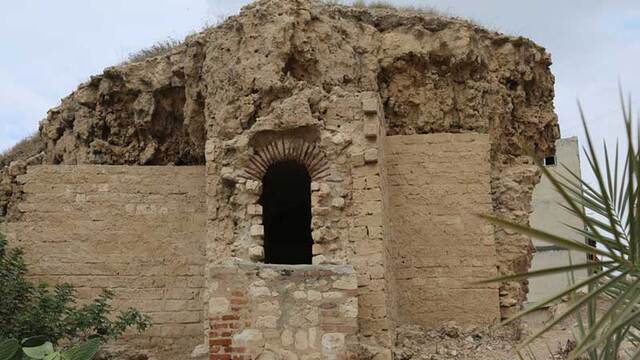
What makes the Catacombs unique is the blending of Egyptian, Greek, and Roman artistic elements. Alexandria, founded by Alexander the Great in 331 BC, was a melting pot of cultures, and this is evident in the catacombs’ artwork and design. The tombs feature Egyptian deities, Greek mythological figures, and Roman architectural motifs, reflecting the cosmopolitan nature of ancient Alexandria. This cultural synthesis is seen in the funerary carvings, which depict Anubis (the Egyptian god of the afterlife) dressed as a Roman soldier and Medusa-like figures, believed to protect the deceased.
Video
Check out the video for a walk around the Catacombs of Kom El Shoqafa in Alexandria, Egypt. It’s a fascinating glimpse into ancient history!
The Architecture and Design of the Catacombs
The Catacombs of Kom El Shoqafa consist of three distinct levels, descending 30 meters (98 feet) underground. The chambers and passageways are interconnected, creating a labyrinthine structure. At the center is a spiral staircase, once used to lower bodies and funeral goods into the depths below.
A striking feature of the catacombs is the Triclinium, or the Hall of Banquets, where mourners once gathered to hold funeral feasts. Stone benches line the room, providing seating for visitors who came to honor the deceased. This practice was influenced by Roman traditions, where feasts were held to commemorate the dead.
The catacombs are adorned with elaborate frescoes, reliefs, and sculptures that showcase a unique blend of Egyptian and Greco-Roman traditions. Key artistic elements include:
- Depictions of Egyptian gods, such as Anubis and Osiris, alongside Greek mythological figures.
- Hieroglyphic inscriptions combined with Latin and Greek script, symbolizing the coexistence of different cultures.
- Ornate sarcophagi and burial niches, each reflecting the wealth and status of the deceased.
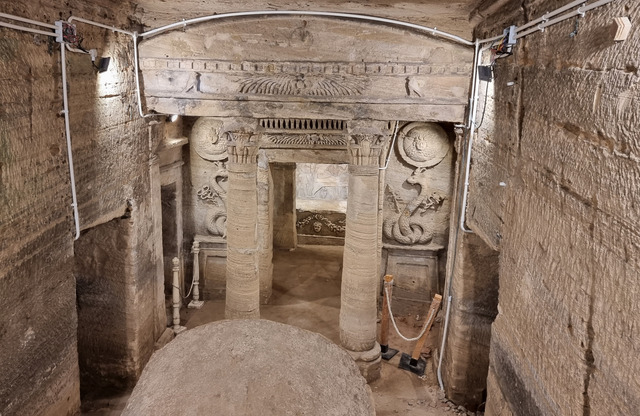
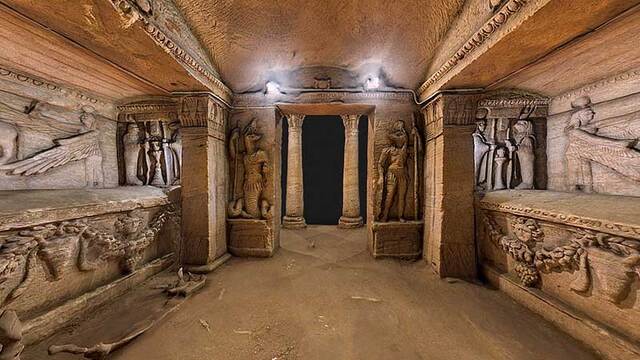
The Rediscovery of the Catacombs
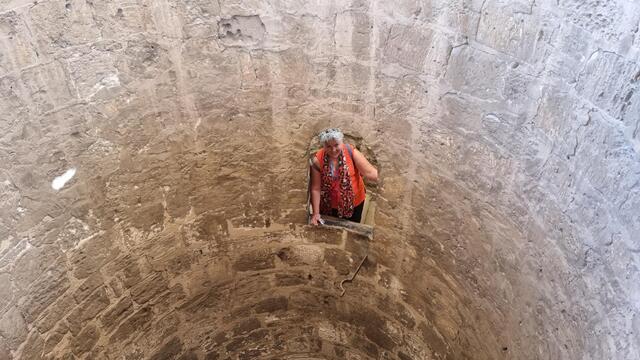
For centuries, the Catacombs of Kom El Shoqafa remained hidden, lost to history until a remarkable accident led to their rediscovery in 1900. A donkey, while grazing, fell into a shaft, revealing the entrance to the underground chambers. This unexpected event led to one of Egypt’s most significant archaeological finds of the 20th century.
Since their discovery, the catacombs have undergone extensive excavation and restoration to preserve their fragile structures. Due to their underground location, the chambers are vulnerable to humidity and groundwater infiltration, requiring continuous conservation efforts. Today, visitors can explore these ancient burial chambers, walking through corridors once reserved for the elite of Roman Alexandria.
Exploring the Catacombs Today
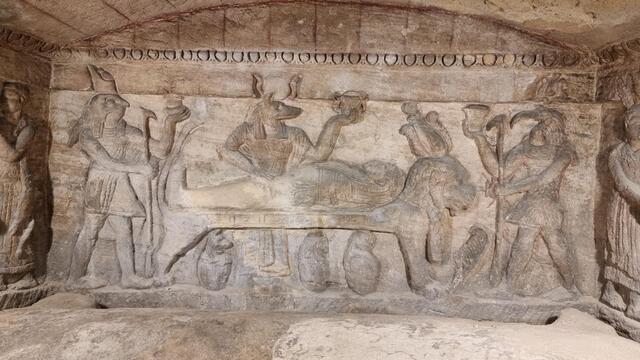
The Hall of Caracalla
Named after the Roman emperor Caracalla, this chamber is believed to have been used for mass burials, possibly for executed soldiers. It serves as a stark reminder of the brutal political conflicts of ancient Rome.
The Hall of Tokens
This chamber was where visitors left offerings for the deceased. Artifacts such as oil lamps, coins, and pottery have been found here, indicating the customs and beliefs of those who visited the site.
The Hall of Repose
This is the main burial chamber, where intricately carved sarcophagi and tomb niches house the remains of the deceased. The presence of multiple tombs suggests that the catacombs served as a family or community burial site.
The Spiral Staircase: A Remarkable Engineering Feat
One of the most architecturally impressive features of the catacombs is the spiral staircase, carved directly into the bedrock. This staircase not only allowed access to deeper burial chambers but also demonstrated the advanced engineering skills of ancient Alexandrians.
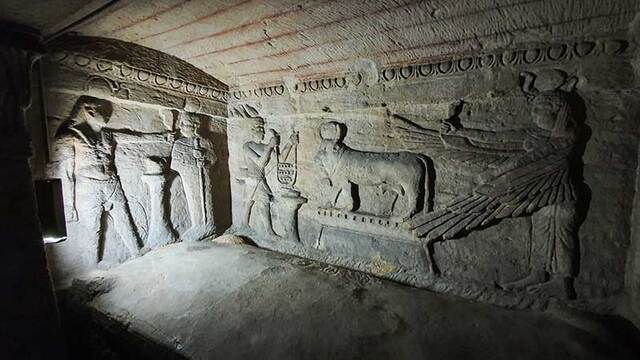
How to Visit the Catacombs
- Best Time to Visit: Early morning to avoid crowds.
- Tour Options: Guided tours provide deeper insights into the history and symbolism.
- Entry Fee: Prices vary, but entry is included in many Egypt tour packages.
Legends and Mysteries of the Catacombs
Some historians believe the catacombs were linked to the Serapeum, an underground temple dedicated to Serapis, the Greco-Egyptian deity of the underworld. This theory suggests the site may have had a religious and ritualistic significance beyond burial practices.
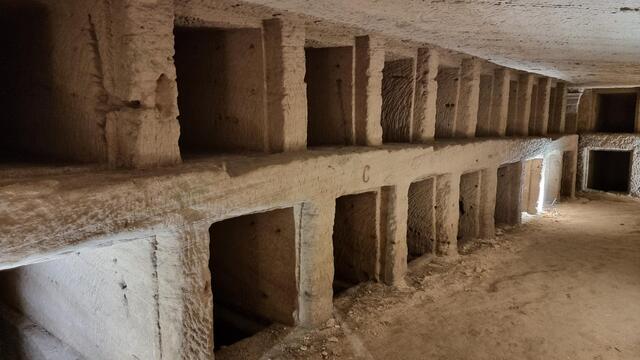
Despite extensive excavations, many mysteries remain:
- Who were the individuals buried here?
- Were there secret passages leading to other parts of Alexandria?
- Did the catacombs serve as a place of refuge during political turmoil?
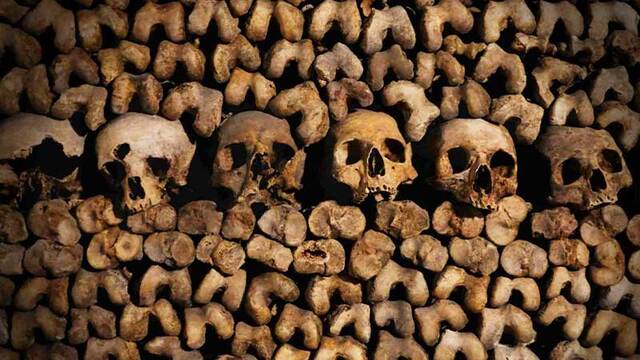
The Catacombs as a UNESCO World Heritage Site
Recognizing their historical and cultural importance, the Catacombs of Kom El Shoqafa were designated a UNESCO World Heritage Site in 1979. This status ensures that preservation efforts continue, allowing future generations to explore one of Alexandria’s most intriguing landmarks.
Due to Alexandria’s rising groundwater levels, the catacombs face erosion and water damage, making ongoing restoration essential. Researchers continue to develop new methods to protect the site while allowing controlled tourism.
Video
Watch the video to uncover disturbing discoveries in Egypt that scare scientists. These eerie findings will leave you questioning history!
Conclusion
The Catacombs of Kom El Shoqafa stand as a testament to the rich and diverse cultural history of Alexandria. Blending Egyptian, Greek, and Roman influences, this underground necropolis offers an unparalleled glimpse into the funerary customs, artistic expressions, and engineering feats of ancient civilizations.
From its accidental rediscovery to its current status as a UNESCO World Heritage Site, the catacombs remain one of Egypt’s most fascinating archaeological treasures. Whether you’re a historian, an adventurer, or a traveler seeking to uncover hidden gems of antiquity, a visit to Kom El Shoqafa is a journey into Alexandria’s mysterious past.



